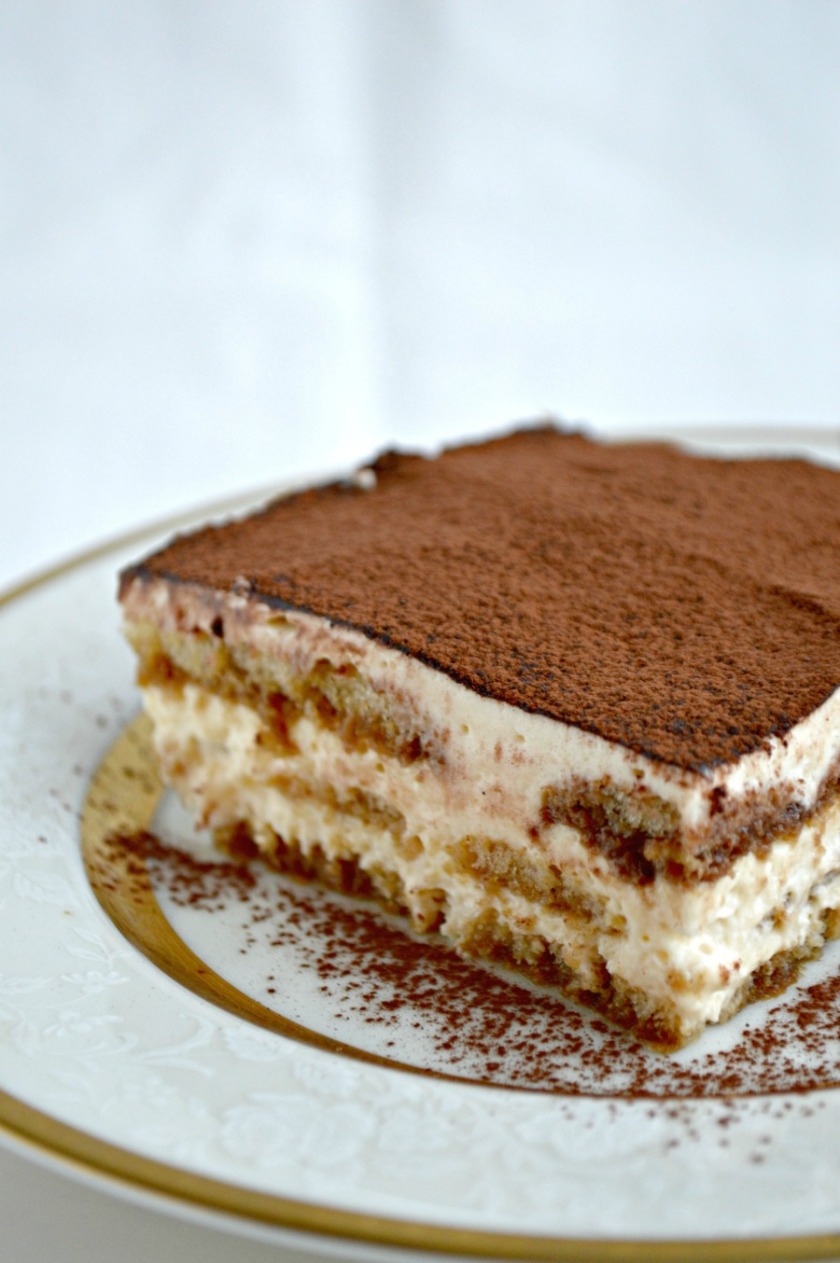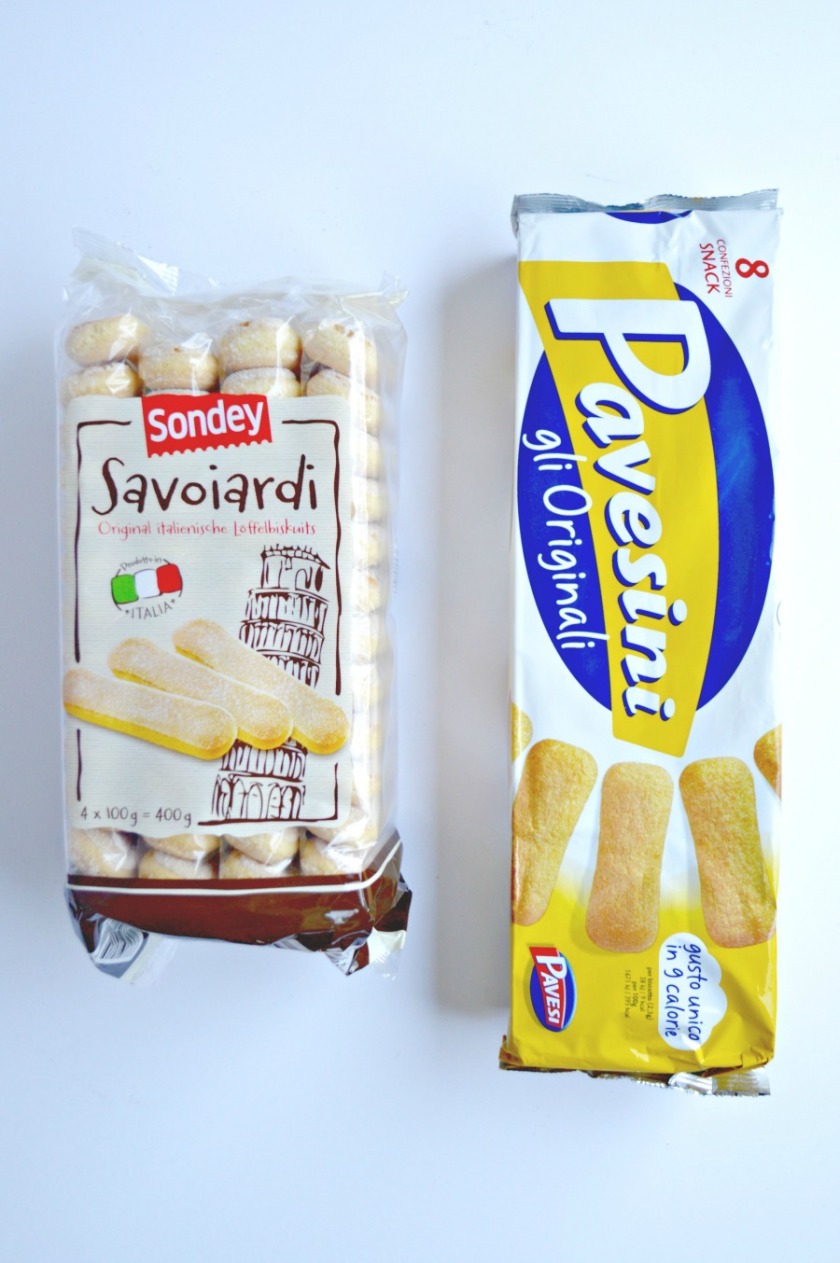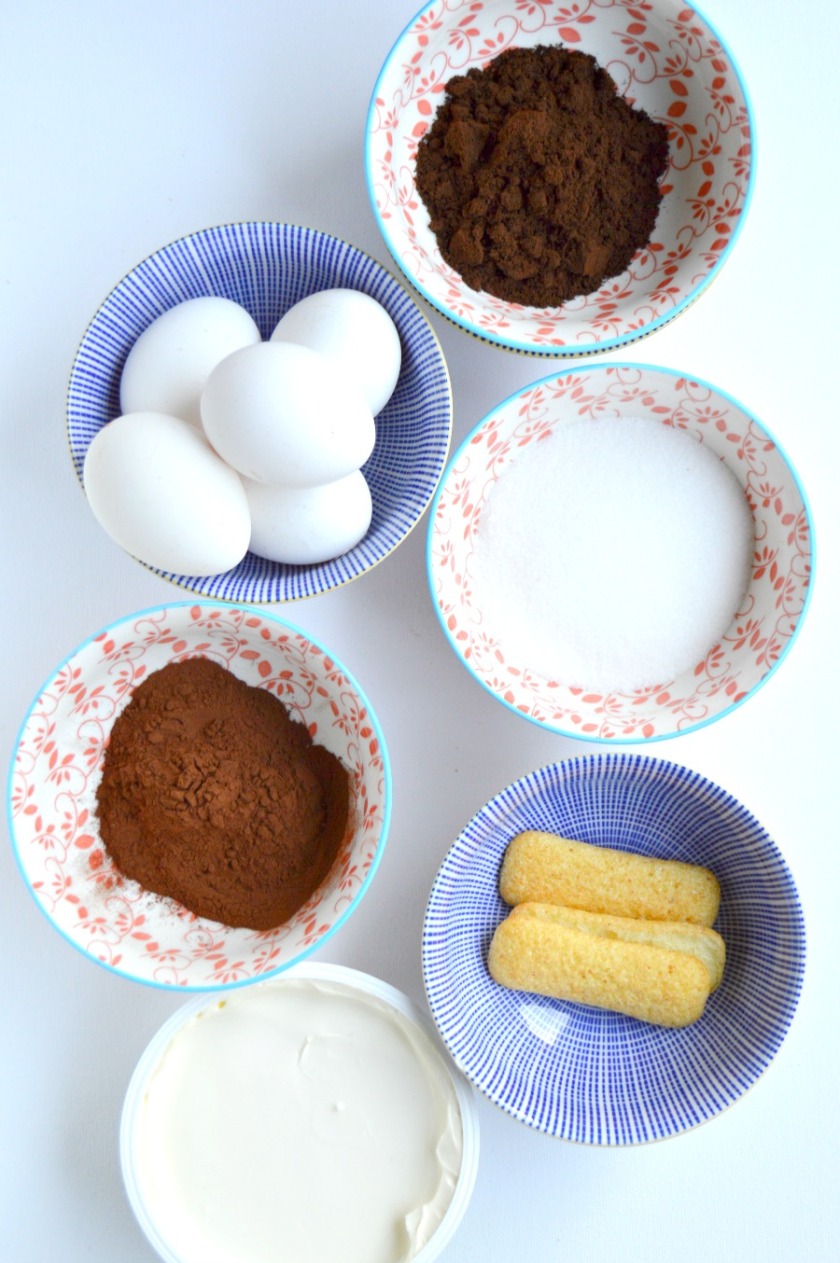Many Italians describe tiramisu as “a piece of paradise in your mouth” … and I couldn’t agree more! It is undeniably the most irresistible dessert in the world! It’s rich, creamy, and very decadent, yet light enough to be served after a satisfying meal. With just a few simple ingredients and techniques, I’ll show you in this step-by-step tutorial, how to make an authentic tiramisu.

The recipe that I’m sharing today for tiramisu has a long history. It all started in the summer 1985, when I was visiting my family in Italy. I was 10 years old at the time. My cousin, Rossana, handed me a neatly handwritten recipe card, and told me that tiramisu was the latest craze in Italy. She had already been making it for a couple of years.
When my mom and I returned to Canada, we made this recipe for just about every occasion – regardless of how expensive the mascarpone was – and we were often asked for the recipe. I’ve made this countless times over the years, and to this day, I always hear that it’s the best tiramisu that someone has ever tried. Unfortunately, I don’t have the recipe card that my cousin gave me, but luckily, I’ve made this so often to the point that I still remember all the ingredients and the steps by heart. 🙂

Tiramisu is a simple custard dessert made of Italian lady fingers dipped in espresso and is then divided by layers of luscious mascarpone cream. In Italy, it is characterised as a dolce al cucchiaio, or a creamy dessert eaten with a spoon. There are so many versions of this recipe, but the original is made of very few ingredients: mascarpone, fresh eggs, espresso, Italian lady fingers (Pavesini or Savoiardi), sugar, and a bit of cocoa powder. There are some rules or tips that I consider important for an authentic tiramisu:
MASCARPONE: This is the most crucial ingredient. Do NOT (and I repeat do NOT) use cream cheese as a substitute! It’s just not the same thing. If you serve tiramisu made with cream cheese to an Italian, they will immediately know the difference.
ESPRESSO: This is the second most important ingredient for an authentic tiramisu. Do not substitute strongly brewed coffee. The flavour of espresso is different then that of regular coffee. If possible, use espresso brewed in an aluminum macchinetta (stovetop espresso maker or percolator). It tastes much better than espresso made from an automatic machine (in my humble opinion). The brand I use most often is Lavazza. Either Crema e Gusto or Qualita Rossa work well. Now, if you can get your hands on Guglielmo Caffe from Calabria, then it will take your tiramisu to another level. 🙂
EGGS: Use the freshest eggs that you can find. If the eggs are too old, chances are your tiramisu won’t set properly and/or the lady fingers will float (this happened to me in the earlier days). To check for freshness, drop an egg into a glass full of tap water. If it floats, then it’s past it’s prime and shouldn’t be used in the tiramisu. You’ll need to buy fresh eggs.
ADDITIONS: An original tiramisu has no heavy cream and no alcohol in it. The only time I have ever made a tiramisu with mascarpone and cream was for a friend who was allergic to eggs. It tasted good but the airiness that you get from the egg whites was missing. As for alcohol, I always make a kid-friendly version at home, but at work, I prepare it with amaretto, which my German customers seem to prefer. (I’m a pastry chef at a local restaurant.) I find that the amaretto (or any type of liquor used in tiramisu) overpowers the natural flavours of mascarpone and espresso.
I probably sound a bit passionate, but these are the things I feel are important for an authentic tiramisu. If some ingredients are hard to come by, then make some adjustments. My only request is that you stay as close as possible to the original thing. If you don’t have a stove top espresso maker, than use instant espresso, or espresso made from a machine. I’ve also made this tiramisu using decaffinated espresso for some people who weren’t allowed to have caffeine, and it still tasted like the original thing. If you feel like adding alcohol, then feel free to do so. The only ingredient that should not be changed is the mascarpone.

COOKIES: Now, this is a question that is frequently debated in Italy: Does tiramisu taste better with Pavesini or with Savoiardi cookies (a.k.a. Italian Lady Fingers) ?
In Fabio De Luigi’s comedy film, Tiramisù (2016), Pavesini cookies are the best choice for tiramisu. They are light, airy, and have a wonderful vanilla flavour. I have made tiramisu with both types of cookies and have found that they are both delicious. However, Pavesini can be hard to come by, if you don’t live in Italy. I found mine at a small grocery store, while I was vacationing in South Tyrol, Italy (which used to be part of Austria before WWI) last summer. They can also be found on Amazon, but I find them to be a bit pricey. I was curious to know if Pavesini could be made at home, and it didn’t take long for me find Alessandra Gambini‘s recipe for Homemade Pavesini. She was so sweet in letting me share her link in this post (grazie mille)! 🙂
As you can see from the photos above, the Pavesini cookie is light and airy, but much smaller and thinner then the Saviordi cookie, allowing them to absorb more liquid (ie. espresso). They also have an intenser vanilla flavour than Savoiardi. However, regardless of which cookie is used, it doesn’t drastically change the flavour of the cake. Savoiardi cookies yield a much taller and sturdier tiramisu but this will be discussed another post. 🙂

For a successful tiramisu, start with fresh ingredients. I’ve already mentioned the importance of fresh eggs, this also applies to mascarpone. Don’t use a mascarpone that expires in a few days, save that for a pasta dish and head out to the grocery store to buy another container of mascarpone.
Brew the espresso in advance and let cool to room temperature. If the cookies are dipped into hot coffee, the cookies will immediately get soggy and fall apart (I remember this happening to me one time when I was a little impatient). Also bring the eggs and mascarpone to room temperature an hour before using.

This recipe makes a 13 x 9 inch (roughly 33 x 23 cm) baking dish, but depending on the shape of pan you are using, you’ll need to adjust the arrangement of the cookies. Pre-lay the cookies so they snugly fit at the bottom. Try to use a pan where it’s sides “go straight up” or don’t flare out. Mine tapers outwards at the the top, which means that the cookies I used in the top layer were spaced apart (you will see what I mean a bit later in this post).
Separate the eggs into two mixing bowls: the egg whites in a medium bowl and the egg yolks in a large bowl. First beat the egg whites till stiff peaks form with an electric mixer and set aside. There is no need to add cream of tartar or extra sugar to the egg whites to stabilise them. They won’t turn to liquid at the bottom as they sit for a few minutes, while you beat the egg yolks and sugar. If you over beat the egg whites, they will lose their structure and the tiramisu might not set properly. Unfortunately, you’ll have to start over again.
NOTE: In the original recipe, it was instructed to beat the egg yolks and sugar first and then the egg whites. The recipe left out an important fact that the beaters need to be washed before whipping the egg whites. Egg whites don’t like fat (protein from the egg yolks). They will never increase in volume if there is just a smudge of grease of any kind. This is the only change that I have made to the original recipe. By beating the egg whites first, it safes a step in washing the beaters, and it guarantees that the egg whites will expand when beaten.
Add the sugar (one tablespoon per egg) to the egg yolks and beat until creamy, about 1-2 minutes. By beating the egg yolk and sugar mixture until thick and creamy, this will help get rid of the egg-y taste. If you beat the egg yolks a little longer till they turn pail yellow and have increased in volume, then you are also increasing the amount / volume the of mascarpone mixture. Add the mascarpone and beat again until smooth and well blended.
Next, gently fold in the stiffened egg whites with a rubber spatula. Be careful not to overfold or the mixture will deflate and look a little runnier. After folding, the mixture should be airy and still hold it’s shape.
QUICKLY dip the cookies into the cooled coffee (no more than 1 or 2 seconds). It may not seem that enough espresso has been absorbed, but the flavour will come through once the tiramisu sets in the fridge. Some people use a spoon for this process, but I like to use my hands. In the earlier days, my fingers always turned brown from the espresso, but now I wear latex gloves to prevent this. 🙂
Lay the wet cookies as previously arranged. And now the fun part …
Add a third of the mascarpone mixture over the cookies and evenly spread to the edges.
Continue dipping the cookies into espresso and lay them perpendicular to the first layer. This is supposed to help keep it’s shape, when the tiramisu is being served. In all honesty, I’m not sure if it really makes a difference. If you lay the cookies in the same direction as the previous layer, it will look aesthecally better when you cut into it. 🙂
Add another third of the mascarpone mixture and spread evenly to the edges.
Dip the remaining cookies in espresso and lay them perpendicular to the second layer (or lay them in the same direction as the previous layers). In the left photo, you’ll see that I was short 3 cookies. This is what I meant earlier about using a baking dish with straight sides (ie. that don’t flare out). If you use a slightly smaller pan, the cookies will be much closer together and you’ll get a thicker layer of mascarpone cream between the cookies. Luckily, I had a second package of Pavesini cookies, and I was able to complete the last layer. 🙂
Spread the remaining mascarpone cream to the edges and here comes the best part …
… sprinkle with cocoa powder (dutch process or unsweetened) until you see no mascarpone cream. Most recipes say to sprinkle cocao just before serving, but I like to it at this stage because
- If the cake reaches the rim of the pan, it is less likely to stick to the plastic wrap when covered (but toothpicks can elevate it a bit higher), and
- Once the cocoa powder has been absorbed, it adds a wonderful, but subtle chocolate flavour to the tiramisu.
After the cocoa powder has been added, cover the baking dish with plastic wrap or aluminium foil and refrigerate for 24 hours. This allows the cookies soften, and the egg whites and mascarpone to properly set.
When it comes time for serving, sprinkle again with cocoa powder and cut into 12 generous pieces. The first piece is always hard to take out, but the rest will look much nicer. 🙂

This is the original recipe that was given to me by my cousin in Italy and that I have been making for the last 30+ years. Everything that I have shared in this post is from personal experience. I always make it with Savoiardi cookies, but whenever I can get my hands on Pavesini cookies, it is definitely a treat! I’m looking forward to trying this recipe again with homemade Pavesini. 🙂
On a last note, Adina over at Where is my Spoon encouraged me to share my recipe for tiramisu. (Thanks for the nudge, Adina!) I will explain that story in the next post, where I make my tiramisu with Savoiardi cookies. 🙂
Have fun with this recipe! If you have any questions or comments about this tiramisu, make sure to leave a comment below!
TIRAMISU WITH PAVESINI
(Printable Recipe)
I got this recipe from my cousin in Italy back in the mid-eighties. I have been making this for over 30 years and I have been told that it’s the best tiramisu that someone has ever tried. Read the post for more details.
Ingredients:
- 1 to 1 1/2 cups (250 – 375 ml) strong espresso, cooled to room temperature
- 1x 7 oz pkg (200 g) Pavesini cookies
- 5 large or extra large eggs, separated
- 5 tbsp granulated sugar
- 16 oz (500 g) mascarpone, room temperature
- 2-4 tbsp cocoa powder (dutch process or unsweetened)
Directions:
1. In a medium bowl, beat egg whites with an electric mixture till stiff peaks form but not dry; set aside.
2. In another large bowl, beat the egg yolks with sugar until creamy, about 1-2 minute. Then add mascarpone and mix until there are no more lumps.
3. Gently fold the egg whites into the mascarpone mixture with a spatula or wooden spoon, but be careful not to overfold.
4. Quickly sip the cookies in espresso and lay them into a 9×13 (ca. 33x23cm) rectangular baking dish (or you may use a slightly smaller pan). Pour a third of the mascarpone mixture onto the cookies and spread evenly to the edges. Repeat step 4 another two times. In the second layer, arrange cookies perpendicular to the previous layer. In the third layer, place the cookies perpendicular to the second layer.
5. Sprinkle generously with cocoa powder, cover the baking dish with plastic wrap or aluminum foil. Refrigerate for 24 hours.
6. Slice into 12 portions and sprinkle again with cocoa powder just before serving.
MAKES 12 SERVINGS





































if i wanted to use amaretto do i put it in with the espresso?
LikeLiked by 1 person
Hi Laura! Correct! Add a shot of amaretto to the espresso. 😊
LikeLike
Now I am craving tiramisù! I like making my tiramisù with Pavesini too. I like the taste and it also looks nicer and neater when sliced. I also put Sambuca in the espresso. I guess it is because my parents have always put sambucca in their espresso-even in the morning😜. Ciao, Cristina
LikeLiked by 1 person
Hi Cristina! My parents used to put sambucca in their espresso, too! It’s been years, though, since I had sambucca. Will have to purchase some soon. Thanks for stopping by!
LikeLiked by 1 person
This tiramisu looks incredible! One of my favorite desserts!
LikeLiked by 1 person
Thanks Brina!! 🙂
LikeLike
This is really the best tiramisu I have ever had!
LikeLike
Thanks, Adina!!
LikeLike
Looks fantastic. I also like the fact that there aren’t too many ingredients to fuss about.
LikeLiked by 1 person
Hi Donald! Thanks for your comment! Sometimes the best things in life are the simple things. 😉
LikeLiked by 1 person
Grazie, Rosa, you don’t wanna know how much we need to divulge the traditional tiramisu recipe, especially this side of the world where I am now 😉 ! It’s exactly how I make it, plus some chocolate shavings (more often with Savoiardi, but I’ve made it many times in Italy with Pavesini, that I love!). I have a recipe too, on our site, and me too, I sound a bit emphatic when sharing the traditional ingredients. Your step by step is beautiful and so useful!
LikeLiked by 1 person
Ciao Nicoletta! I truly believe in staying as close as possible to the original. I checked out your recipe for tiramisu and it sounds delightful! I find it interesting the eggs are pasteurised (I also found a posting/video on Giallo Zafferano). When time permits, I will have to try it. Thank you for your lovely comment!
LikeLike